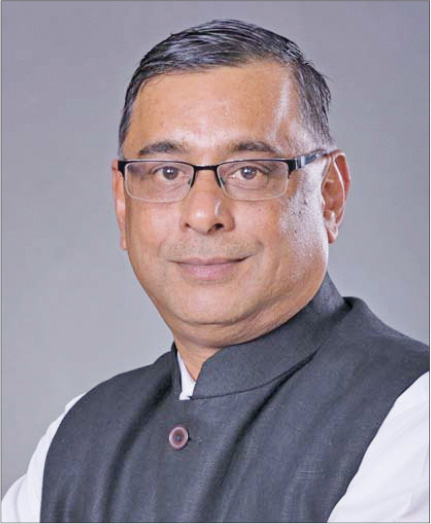The interim budget for 2024-25 has been largely welcomed by the power industry for its nuanced approach to sustainable growth. The budget includes the announcement of key measures aimed at achieving net zero by 2070. These include the provision of viability gap funding (VGF) to tap the offshore wind power potential, expansion of rooftop solar schemes to cover 10 million households with incentives for generating clean energy, and the development of a 100 million tonne capacity for coal gasification and liquefaction by 2030 to reduce the reliance on imported fossil fuels. These initiatives underscore the government’s commitment to fostering a cleaner, greener and more self-reliant power sector, positioning India as a leader in sustainable development and renewable energy innovation.
A summary of reactions to the Union Budget 2024-25 from power sector leaders…

Pratik Agarwal
The budget’s emphasis on research and development (R&D) is path-breaking. The substantial Rs 1 trillion corpus, paired with a 50-year interest-free loan, presents a significant incentive for the private sector to scale up R&D investments in sunrise domains. Implementation will be the key to realising the full potential of this opportunity.

Gyanesh Chaudhary
With its clear vision, sound structure and commitment to fiscal prudence, this interim budget continues on the path towards Atmanirbhar and Viksit Bharat (a self-reliant and prosperous India). The significant 11.11 per cent increase in capital expenditure will act as a catalyst for economic growth and job creation, ensuring inclusive growth for the nation. The prime minister’s ambitious vision of rooftop solarisation will provide 300 units of free electricity to 10 million households every month, resulting in savings of Rs 15,000-Rs 20,000 per year. This significant announcement promises a bright future not only for the renewable energy industry but also for numerous enthusiasts and entrepreneurs urging new employment opportunities. “First Develop India” through increased FDIs and the government’s efforts to negotiate bilateral investment treaties augur well for Indian entrepreneurs. Also, efforts to promote green growth through bio-manufacturing are a step in the right direction to achieve our net zero targets.
By prioritising the development of the eastern region and unlocking its potential as an engine of national growth, the government demonstrates its commitment to balanced and inclusive development across the nation. Guided by the principles of “reform”, “perform”, and “transform”, the government is navigating these turbulent geopolitical times with confidence. Under its leadership, the Indian economy is poised to shine even brighter on the global stage.

S.N. Goel
The budget promises unprecedented growth for India in the next five years, focusing on the growth pillars of green energy and infrastructure development. It has laid the foundation for a resilient and sustainable energy future. The rooftop solarisation programme, which aims to provide 300 units of free power every month to 10 million houses, along with an opportunity to sell surplus energy to discoms, will take the solar energy programme to the grassroots level, generating substantial savings for households. Additionally, the policy mandating the phased blending of compressed biogas (BG) for compressed natural gas (CNG) and piped natural gas (PNG) will help in greening the gas supply chain.

Girishkumar Kadam
The budget’s focus on green energy measures reinforces the commitment to achieving energy transition in the long run. The VGF scheme for 1 GW of offshore wind energy projects is expected to improve their cost competitiveness and will further contribute to renewable capacity addition in the long run. In addition, measures to promote rooftop solar remain positive for the renewable sector. Also, the higher budgetary allocation for the reform-linked distribution capex scheme will assist state discoms in augmenting their infrastructure and improving operational efficiencies. Given the country’s abundant coal reserves, the stated intent to implement a 100 mt coal gasification and liquefaction facility will benefit the chemical sector by improving domestic synthetic natural gas availability and lowering the import dependency on ammonia and methanol in the long run. Further, the proposed expansion of nano-DAP application in all agro climatic zones will benefit the fertiliser sector by reducing imports as well as subsidy requirements. Moreover, the mandatory use of CBG in CNG and PNG is a step in the right direction to meet the growing demand for natural gas in the country. It is also expected to benefit entities in the city gas distribution (CGD) sector by reducing dependency on imported liquefied natural (LNG) gas.

Saurabh Kumar
The interim Union Budget 2024 not only signifies a landmark in India’s journey to a net zero economy by 2070, but reflects the government’s vision of Viksit Bharat, which anchors on the pillars of energy security and accessible, affordable clean energy. The rooftop solar scheme marks a significant milestone for scaling up India’s clean energy ambitions. The push for an EV ecosystem creation and the large-scale roll-out of e-buses through payment security mechanisms will decarbonise the mobility sector while propelling India as a potential EV manufacturing hub. The announcement of the Rs 1 trillion corpus is a remarkable step to attract private investment in innovation, and R&D in the clean energy sector.

Kush
The interim budget 2024-25 has laid the foundation to transition towards reliable, cleaner, greener and sustainable energy. The government’s commitment to providing free rooftop solar electricity to 10 million households signifies a strategic move towards resource-efficient economic growth. This initiative not only ensures energy security but also promotes entrepreneurship and employment in the evolving renewable energy landscape.

Rajiv Ranjan Mishra
The interim budget 2024, presented by Finance Minister Nirmala Sitharaman, continues on India’s path of fiscal consolidation. It aims to lay the foundation for a Viksit Bharat by focusing on inclusive growth and sustainability. Aligning with this priority, the government’s focus on skilling, health, energy security and micro, small and medium enterprise growth, as well as the 11.1 per cent increase in capital expenditure, will position India as a manufacturing hub and an investor-friendly country. On the sustainability front, the government’s commitment to achieving its net zero target is commendable. To this effect, VGF for harnessing the offshore wind energy potential for an initial capacity of 1 GW will help the sector step up its pursuit of developing wind assets that will contribute to the country’s net zero and energy security goals. The importance placed on EV infrastructure and green energy will also drive the country towards a more sustainable future and green Amrit Kal.

Vineet Mittal
In the interim budget 2024-25, the finance minister has outlined the country’s development philosophy, which aptly involves both social and geographic inclusion. She has given a detailed account of the government’s performance in the past 10 years through hard facts and figures. While it was an interim budget, the government has displayed consistency in its approach to India’s march towards “Amrit Kaal”. Increased emphasis on women’s empowerment and R&D will go a long way in developing India’s growth story. The government’s plan for fiscal consolidation and fiscal deficit reduction to 4.5 per cent by financial year 2026 shows its commitment to fiscal discipline in the future. The increased allocation to the infrastructure sector from Rs 10 trillion last year to Rs 11.11 trillion is encouraging. The announcement of new railway corridors for energy, minerals and cement, port connectivity corridors, and high traffic density corridors will boost the economy.
For the energy sector, some notable announcements that will accelerate the government’s decarbonisation agenda include rooftop solarisation for 10 million households, which is commendable. Also, VGF for 1 GW of offshore wind projects; development of a 100 mt coal gasification and liquefaction capacity by 2030; mandatory blending of CBG in CNG for transport and PNG for domestic purposes; and financial assistance for the procurement of biomass aggregation machinery are a shot in the arm. New manufacturing schemes to incentivise industries producing biofuels, biopolymers, bioplastics, biopharmaceuticals, etc. will ensure comprehensive growth within a circular economy. I think, overall, this is a very well-balanced budget that also provides glimpses of the government’s strategic roadmap for the Amrit Kaal.

Sharad Pungalia
The budget announcements regarding renewable energy demonstrate a progressive approach by the government. Specifically, the initiatives aimed at promoting rooftop solarisation signal a strategic framework to leverage India’s substantial residential market for renewable energy adoption. Additionally, the announcement of VGF for offshore wind energy projects, with a focus on capacities up to 1 GW, is a welcome move. This provision addresses the critical need for propelling the growth of offshore wind energy, which had witnessed a flat trajectory in the past few years. While the demand market has been incentivised, relaxations in import taxes would have also helped generators achieve the targets associated with the rise in energy demand till local manufacturing stabilises.

Venkatesh R.
India has pledged to achieve net zero emissions by 2070. The country has a target of 500 GW of renewable energy capacity by 2030. The urgency of the situation is unequivocal, and the solution is equally clear: we need to triple renewable energy and require a seismic change in the level of investment – up to $5.7 trillion per year by 2030 – to put us on course for the 1.5 °C Paris Agreement scenario. The announcements made in the 2024 budget are encouraging steps in the right direction. The finance minister has allocated significant resources to bolster the green energy sector, with a focus on harnessing India’s vast offshore wind energy potential. The emphasis on “green growth” underscores the holistic approach, recognising the integral role of environmental sustainability in economic development.
Wärtsilä’s recently launched its report, “Every Second Counts”, covers the three crucial principles for policymakers and the wider energy industry to follow when designing India’s future power systems. Firstly, we need to ensure that we are choosing the right technologies. The build-out of wind and solar power must be matched with flexible grid balancing engines and energy storage to ensure the optimal, lowest cost power mix. Secondly, we must design our energy markets to support flexibility. For example, creating capacity markets to ensure developers receive a return on their investment, even if a plant runs only intermittently to balance demand. Finally, we should introduce shorter time frames, using 15- or even 5-minute time resolution in power market trading.

Deepak Sharma
The interim budget provides a robust blueprint for Viksit Bharat. It comprehensively addresses all sectors of the economy, with a specific emphasis on fostering innovation, research and entrepreneurship. Setting up a corpus of
Rs 1 trillion and providing a 50-year low interest loan for tech-savvy youth will scale up research and innovation. The budget also demonstrates a noteworthy commitment to sustainability, particularly in the energy sector. The promotion of solar rooftop installations, provision of 300 units of of free power every month to 10 million households, mandatory blending of CBG with CNG and PNG, and incentives for offshore wind energy will ensure energy accessibility, affordability and availability. There is also a noteworthy focus on strengthening the EV ecosystem by supporting the charger manufacturing infrastructure. Increasing the number of EV buses on the roads is a welcome environmentally friendly step.
The interim budget lays emphasis on accelerating infrastructure development in cities to cater to the growing population demands. The affordable housing scheme for the middle class will help in improving their living standards. Steps like the expansion of urban infrastructure with metro rail, NaMo Bharat trains and expansion of existing airports under the UDAN scheme will ease commute and boost connectivity.

Sumant Sinha
This is a very welcome and forward-looking vote on account presented by the finance minister. The strategy laid out reflects the prime minister’s vision of a modern, inclusive, resilient, innovative and green India. The continued thrust on capital expenditure and reduced market borrowings will accelerate private investments and employment creation. The budget balances growth with fiscal prudence.
The continued priority to achieve rapid growth in the green energy sector is clear. Announcements on VGF for offshore wind energy and allocations for solar rooftop projects will support the development of the entire industry. The announcement of the Rs 1 trillion corpus for research and development in the sunrise sector sets a positive tone for the future, encouraging us to accelerate our investments and innovations in renewable energy technologies.

Viral Thakker
The Government of India’s interim union budget sustainability measures are timely, and indicative of a forward-looking and responsible approach towards building a resilient and environmentally conscious nation. The “Rooftop Solarisation and Muft Bijli” initiative, in pursuit of net zero emissions by 2070, will also unlock annual savings from free solar electricity and the sale of surplus to distribution companies, EV charging, entrepreneurial opportunities for many vendors, and employment prospects for technically skilled youth. Other multifaceted efforts, including several other green energy measures, such as funding for offshore wind energy, setting up a coal gasification capacity, mandatory blending of CBG in natural gas for transport and PNG for domestic purposes, financial support for biomass aggregation machinery to ensure efficient energy collection, are a welcome step in the right direction.
The launch of the scheme for restoration and adaptation measures, and coastal aquaculture and mariculture under the “Blue Economy 2.0” will support climate risk mitigation and create sustainable livelihoods while safeguarding our marine ecosystems.

N. Venu
The finance minister’s interim budget speech presents a progressive outlook for the entire economy, with a focus on keeping all growth levers intact for sustainable, inclusive growth for all.
Starting with fiscal consolidation aimed at reducing the deficit and improving tax collection, along with strategic futuristic investments, lays the foundation for strong economic growth in the new financial year. To enhance India’s role in today’s redefined globalised world, the budget deploys a 360 degree method – regulatory, financial and advisory support to small and medium enterprises, long-term financing at close to zero interest for private sector R&D, innovation in sunrise sectors and establishment of the three economic rail corridors (energy, cement and mines; ports and high traffic density) under the PM Gati Shakti programme. The last will not only improve logistics efficiency but also contribute to reducing overall transportation costs.
We commend the government’s steadfast commitment to environmental sustainability and the ambitious goal of achieving net zero by 2070. The focus on supporting offshore wind energy through VGF and developing coal gasification and liquefaction capacity demonstrates a proactive approach to diversifying our energy sources. Furthermore, rooftop solar that taps into our populace and payment security mechanisms to incentivise city and state transport to adopt EV buses will help create a robust, sustainable renewable ecosystem.
Overall, we feel the interim budget can provide the required impetus and momentum to maintain sustainable growth across sectors.
